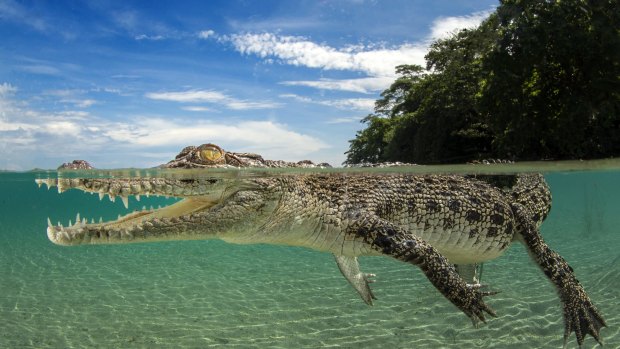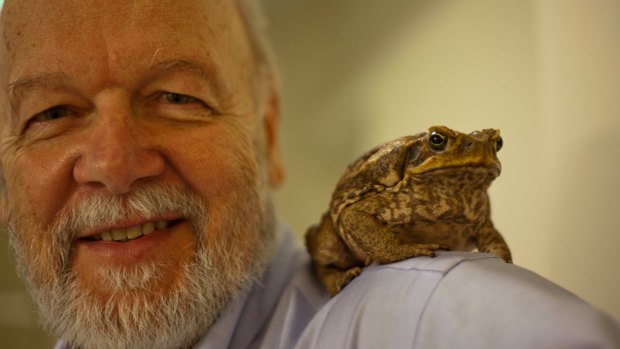This was published 8 years ago
Eureka Prize finalists: how not to eat a cane toad and other advances in science
By Marcus Strom
Teaching quolls how not to eat cane toads, understanding bee-colony collapse and record-breaking solar cell technology: just some of the research listed as finalists in this year's Eureka Prizes for Science announced by the Australian Museum on Friday.
Across 16 categories, 49 finalists are in the running to share $160,000 in prizemoney in celebration of the best and brightest science in Australia this year.

Salty: Justin Gilligan is a finalist for the Eureka Prize for Science Photography for this photograph of a saltwater crocodile in Kimbe Bay, Papua New Guinea.Credit: Justin Gilligan
Three finalists and seven highly commended entrants were also announced for the Eureka Prize for Science Photography.
"The finalists show the depths of science innovation and research in Australia," Kim McKay, director of the Australian Museum told Fairfax Media. "The STEM [science, technology, engineering and maths] are Australia's future and the Eureka Prizes highlight that."
Ms McKay said that the prize for rural innovation is a new category for 2015.
"Anything that supports our agricultural industries is critical for Australia's biosecurity," she said.
As a Sydneysider she is particularly impressed with research aimed at combating disease in the oyster industry.
"But all our finalists are extraordinary," she said, highlighting solar research at the University of South Australia and University of NSW in the innovative use of technology category.
Finalists for innovative use of technology include Mark Keevers and Martin Green at the University of NSW. By "splitting" a single beam of light across two different types of cell the scientists at the Australian Centre for Advanced Photovoltaics achieved more than 40 per cent energy conversion efficiency in solar cells, a world record.
In other research, mathematician Mary Myerscough at the University of Sydney worked with biologist Andrew Barron at Macquarie University to study honey bee colony collapse. Dr Myerscough told Fairfax Media honey that bee colonies were collapsing because the foraging bees were dying, "sucking other bees out of the hive" before they were ready to find food.
This can lead to colony collapse within three weeks. The foraging bees are dying early due to pesticide use, climate change, imbalanced diet and bee diseases, she said.
Dr Myerscough modelled different techniques that could help support the hives: add pupae to support the population, provide more feed to endangered colonies or find methods to prevent hive bees leaving early to become foraging bees. Her models suggest that the best method is to feed the hives with nectar and pollen substitutes, or even using sugar water. Dr Barron is now testing these models in the field.

Dr Rick Shine, biologist at the University of Sydney. Finalist in the 2015 Eureka Prizes for Science for his research on cane toads.
Rick Shine, of the University of Sydney, has worked with Jonathan Webb, of the University of Technology Sydney, and Stephanie O'Donnell on the impact of toxic invaders on native predators.
They train quolls how not to eat cane toads.
Dr Shine found that large native predators in cane toad-invasion zones between Darwin and Kakadu were vulnerable to the exotic toads' poison. Some populations of quolls, goannas, brown snakes and even crocodiles faced up to 95 per cent mortality when confronted by the invading toads, Dr Shine told Fairfax Media. The problem is that the frontline invading toads tend to be very large with enough poison to kill.
The researchers found that by feeding very small non-lethal toads to quolls, blue-tongued skinks and flood-plain goannas that the predators developed taste aversion and wouldn't then eat the larger, lethal toads. The aversion therapy was enhanced by including a common agricultural nausea inducer.
While it isn't clear if the endangered northern quolls are able to teach their young to avoid the toads, the aversion to eat them could provide one generation a time buffer until the toad populations stabilise and start to breed young, which are less toxic.
The three finalists for the Eureka Prize for Science Journalism are: ABC's Catalyst team for Gut Reaction, on the relationship between bacteria and food in our guts; Sally Ingleton for her ABC documentary on The Great Australian Fly; and Cosmos magazine editor-in-chief Elizabeth Finkel for her feature, A statin a day.
The full list of finalists can be found on the Australian Museum Eureka Prize web page. The winners will be announced on August 26.